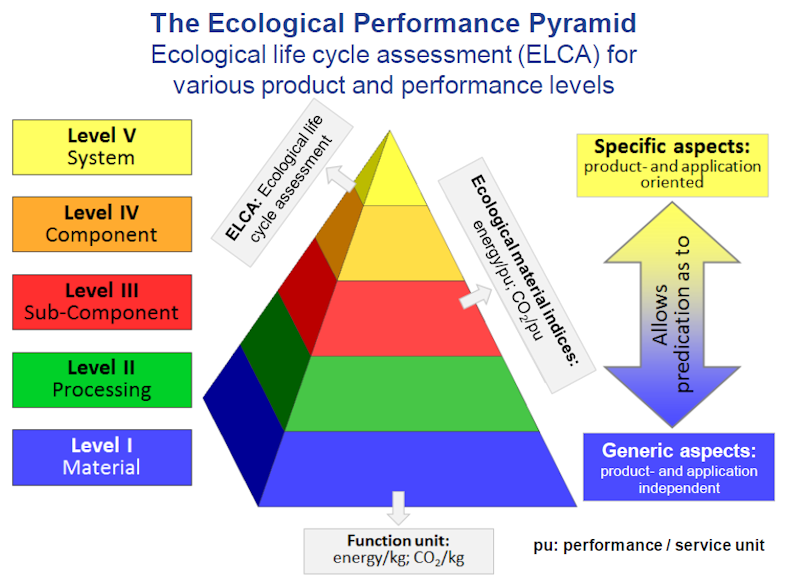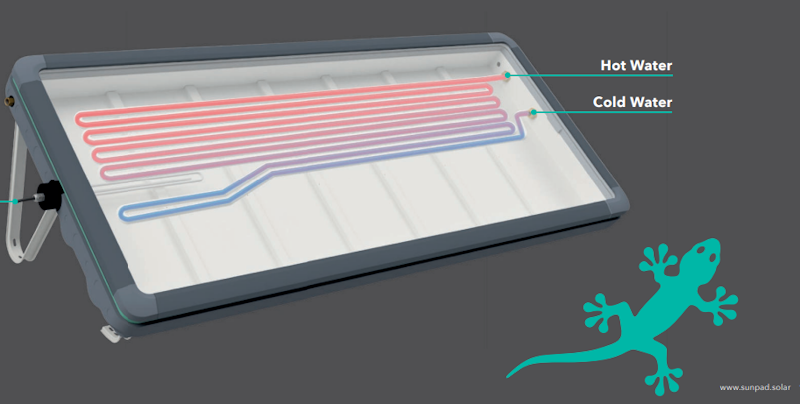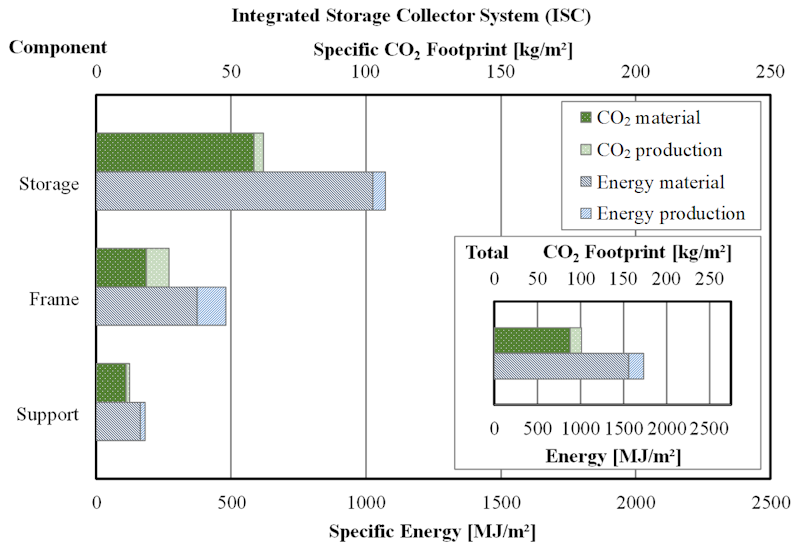Posted: August 24, 2023

Chart: JKU
The Johannes Kepler University Linz (JKU) wants to support the IEA Solar Heating and Cooling Programme with life cycle analysis of solar water heaters. During the last meeting of IEA SHC Task 69 on Solar Hot Water for 2030 in April 2023 Harald Kicker from the Institute of Polymeric Materials and Testing at JKU presented eco-analysis results related to all-polymeric solar water heaters. The solar heating systems achieved an energy payback period of 0.7 to 1.3 years depending on the intensity of the sun at the location. The JKU approach could be applied to thermosiphon systems and PV hot water systems to compare the greenhouse gas (GHG) savings potential of different solar water heater technologies.
“The JKU team moderated an excellent technical discussion on durability and reliability of materials and overall energy and GHG saving potential during our last task meeting”, commented Robert Taylor, Co-Manager of Task 69 and Associate Professor at the School of Mechanical and Manufacturing Engineering at the University of New South Wales in Australia.
The JKU team led by Prof Gernot M. Wallner uses the database ecoinvent, which is one of the world's largest life cycle inventories supporting environmental assessments of products and processes worldwide. Kicker also achieved useful results using the tool SimaPro to monitor sustainability key performance indicators. SimaPro accesses the ecoinvent database and is therefore always up-to-date with regard to emissions from materials and manufacturing processes. Transport is neglected in Kicker's LCA because “you rarely have data on it and it's irrelevant if you want to compare different technologies with each other.” Regarding the end-of-life-potential, the embodied “grey” energy of polymeric materials was considered adequately.
First life cycle assessment for Sunpad – an integrated storage unit
"To perform an LCA for solar water heating system with these tools, we need the exact bill of materials and data from solar yield measurements, as well as the assumed lifetime," explained Kicker. He gained his first experience by analysing the carbon footprint of Sunpad – a polymer-cased, integrated storage collector that Greenonetec developed and first presented during the ISH 2019. https://solarthermalworld.org/news/sunpad-cost-effective-integrated-storage-collector/ The notable difference between Sunpad and a thermosiphon system is that in the new product the collector and tank are merged into one unit, so that building owners will no longer have to deal with large metal vessels on their roofs.

A stainless-steel heat exchanger pipe matrix has been integrated into the upper section of the comparatively flat Sunpad storage tank. Illustration: Greenonetec
The JKU team carried out an LCA for a prototype of the Sunpad collector with the integrated storage made from polymers in 2018 before the launch of the final product, which has a metal, integrated heat storage tank. “The prototype had a rather small carbon footprint of about 8 g CO2/kWh assuming that the polymers are recycled, as in this case the captured CO2 content of the material remains bound during recycling”, said Kicker. The carbon footprint is much higher at about 60 g CO2/kWh if the polymers are burned and the intrinsic CO2 content is released. Both figures take into account the solar yield over the 25-year lifespan. The following chart shows that the storage tank has the highest impact on the carbon footprint, because it contains the most material.

Life cycle analysis of the prototype of an all-polymeric, integrated storage solar water heater carried out in 2018
Source: JKU
Comparison of PV and solar thermal hot water systems in South Africa

Comparison of performance data for a 1.56 kWp PV system (10 m2 of PV module area) and an indirect 2.4 m2 solar water heater installed on two separate houses at Mariendahl Farm in South Africa, carried out by the Centre for Renewable and Sustainable Energy Studies at the Stellenbosch University in 2018/2019. The systems were designed with a similar thermal capacity and both equipped with a 200 litre storage tank, capable of effectively supplying a household with 3 to 4 residents with hot water.
Photo: Stellenbosch University
Kicker assumes that the CO2 carbon footprint of thermosiphon systems, in which the storage is separate from the collector, is significantly larger to that of the Sunpad because more metal is used. According to Wallner, the emissions balance for PV hot water systems will be even higher than for thermosiphon systems, because you need four times the area of PV modules and still need a thermal storage system. This was shown in a comparative study by the University of Stellenbosch in South Africa (see photos above).
JKU is looking forward to cooperating with the Task 69 team and hopes to cooperate with thermosiphon system manufacturers, who will provide the institute with parts lists of the materials with weight and performance data over the lifetime.
|
|
Number of people in the household
|
Hot water demand per person per day
|
Annual heat for hot water demand per household
|
Solar fraction over the year
|
Total heat input to the 200 litre tank over the year
|
Losses of the storage tank over the year
|
|
Solar water heater system
|
3 persons
|
67.6 litres = 2.28 kWhth/day
|
2,497 kWhth / year
|
70.4 %
|
2,219 kWhth from solar and 934 kWhth from the grid
|
656 kWhth/year
|
|
PV hot water system
|
1 person
|
52.6 litres = 2.13 kWh/day
|
775 kWhth / year
|
95.6 %
|
1,402 kWhth from solar and 65 kWhth from grid
|
693 kWhth/year
|
Monitoring results from 1 May 2018 to 30 April 2019 for the two residential houses at Mariendahl Farm. The high solar fraction, when compared to that of the SWH system, is primarily influenced by the lower hot water consumption and the system being designed for a larger usage. Unfortunately, the results are not as comparable as desired, since the two households were very different in size.
Source: Stellenbosch University
Websites of organizations and tools mentioned in this news article: